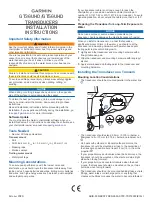
6
Development Objectives for the TS-480 Series
The following is an explanation of our development objectives, distinct from the planning
objectives.
If asked about the origins of the compact HF rig, people outside Japan would no doubt think of the
Atlas Series. Following the Atlas, a variety of different products appeared on the market, but it is
probably no exaggeration to say that Kenwood’s TS-50 was the first in the category of the 100W
(HF) compact all-mode transceiver. It is already more than a decade since the TS-50 was
launched. Since then, successive models have grown increasingly smaller while adding new
features and expanding band coverage to include V/UHF. Today, this category has matured to the
point of actually forming a definable market. What we developed in order to stir up and add fresh
stimulus to this market was the TS-480 Series.
•
Why a compact 200W transceiver?
•
Why a 100W model with a built-in antenna tuner?
•
Why HF~50MHz coverage?
The answers to these questions can be found in our planning objectives. Let’s look at the technical
background.
The TS-480 concept began with development of the TS-570?
We first started looking in detail at the technical feasibility not of the 200W model but of the model
with the internal antenna tuner. Today, there is nothing special about a built-in AT, but for the
TS-570 we developed a relay-type AT. This replaced the previous motor-driven variable capacitor
type of AT. Naturally this technology was used elsewhere and by other manufacturers, but if
applied not to TX but to RX also, it is possible to use it for receiver front-end passive tuning. For
transmission purposes, it is smaller than the conventional type of AT of the time, especially with
regard to height, making it a good choice for building into a compact set.
In 1996, when on a visit to the US to promote the TS-570 a local salesman asked whether we
were next going to put an AT into the TS-50. Well, perhaps that was where the TS-480 got its start!
Achieving 200W output in a compact transceiver
In achieving our goal of 200W there was one major constraint – namely, we could not raise the
voltage of the power supply. The TS-480 Series was to be sold not only in Japan but internationally.
If we had been looking only at our domestic market, things would have been different since the
output of mobile transceivers here is limited to 50W, but conditions are different abroad, especially
in the US. In the US, since there are no limitations on the output of either mobile or fixed stations,
mobile transceivers in the several hundred watt class are not unusual. A common pattern for
operations is not to hook up a 100W unit to a linear amp and mount a 200W fixed transceiver in a
car. Moreover, the most common type of vehicle is a pickup with a 12V battery, so people expect to
obtain a 200W output with a regular 13.8V power supply.
If one thinks of the way people operate such transceivers here in Japan, a question arises: Why
add that much power if it cannot be used as a mobile rig? The TS-480 has been designed with a
priority on operating ease. One reason for this is that we saw the TS-480 being used as a fixed
station in Japan, where 200W mobile operations are not permitted. Most 200W HF transceivers
are high-end and their price reflects this. But in the workhorse class, most models offer only 100W
output. So we can say that our new product can fulfill the wishes of those who have received an
advanced permit and thus want a 200W rig – as long as it is not expensive.
Содержание TS-480
Страница 1: ......
Страница 12: ...12 Fig 4 200W final section Fig 5 100W final section with antenna tuner ...
Страница 24: ...24 Fig 15 NR OFF Fig 16 NR1 ON Fig 17 NR2 ON ...
Страница 54: ...54 ...







































